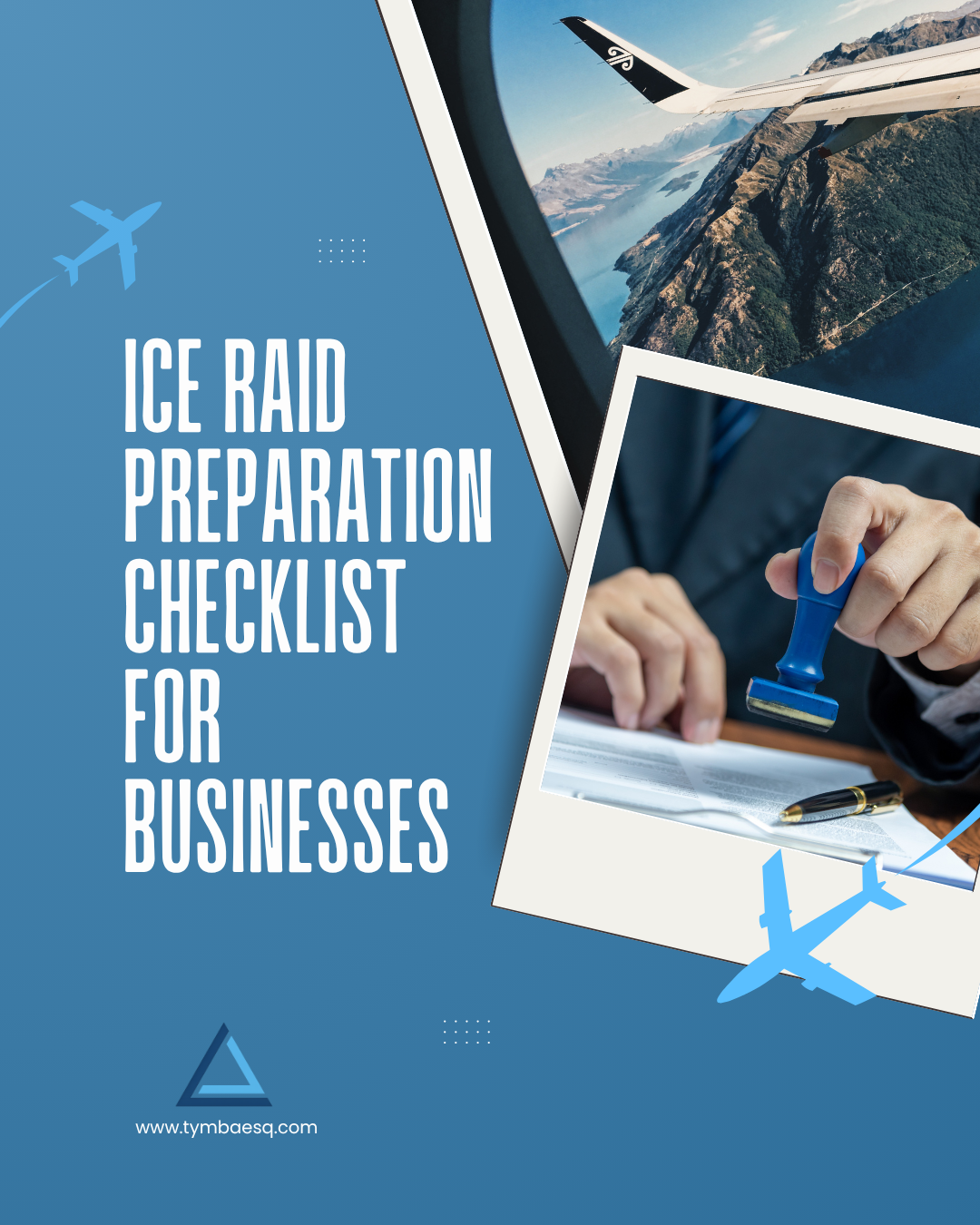ICE Raid Preparation Checklist for Businesses
Author: Ty Leitow
Last Updated: October 6, 2025
2025 has brought many changes to the United States, some positive, and many not so positive. For businesses, one key takeaway is clear: immigration law must be taken seriously. ICE has become a well-funded and increasingly aggressive enforcement organization, sometimes acting within traditional legal boundaries, and sometimes driven by political motivations.
Regardless of the reason, the current trend is an increased frequency and intensity of ICE activity. Legal departments and compliance officers need to be ready to respond accordingly.
So, what should you do when ICE shows up at your workplace to execute a raid?
1. Stay Calm, Cooperative, and Composed
First, stay calm and be cooperative, no matter how you feel about ICE or the fact that a raid is happening at your business. Remain professional, courteous, and composed.
Greet the officers and ask to speak with the lead agent. Request identification and clarification about the purpose of the investigation. Ask to see the warrant, take a copy or photo of it, and review it carefully.
2. Review the Warrant
A properly executed warrant should clearly outline what ICE can do, and often by omission, the warrant will also indicate what ICE cannot do. Check for basic details like names, address, and dates. Generally, there are two types of warrants ICE agents will use: a Judicial Warrant, and an Administrative Warrant.
A Judicial Warrant is signed by a judge, and usually has a larger scope and more authority. Judicial warrants will often authorize ICE agents to detain employees, confiscate records, and enter non-public areas of the company.
An Administrative Warrant is signed by an ICE official, not a judge. These warrants usually have a smaller scope and grant less authority. ICE agents may be authorized to enter public areas of the business and serve a notice of investigation or audit. Unlike Judicial Warrants, Administrative Warrants usually do not allow ICE to detain employees or enter non-public areas of the business.
Importantly, ICE may do things outside the scope of a warrant if you give consent. To prevent this, companies should train employees on how to interact with ICE and designate specific points of contact to manage consent and communication.
3. Notify Legal Counsel and Management
Once you understand the purpose and scope of the raid, contact your legal counsel immediately and notify senior management. Share a copy of the warrant with your attorney and brief management on what to expect as ICE conducts the raid.
4. Accompany ICE Throughout the Premises
An individual knowledgeable about basic immigration laws, or a small management group should accompany ICE throughout your worksite. Ideally, a lawyer or trained executive will be the liaison for your company to ICE. Generally, you do not want to consent to actions outside the warrant’s authority, such as granting access to restricted areas or providing information about employees not named in the warrant.
5. Do Not Interfere with the ICE Investigation
Your goal is to protect the company and its lawful employees without interfering with a valid investigation.
DO NOT do any of the following:
(i) hide employees or assist them in leaving the premises,
(ii) provide false or misleading information, or
(iii) shred or destroy any documents, records, or files.
If ICE requests documents, records, or files, make sure the warrant authorizes such access. For example, in a Form I-9 Audit, a business generally has 3 business days before it must disclose I-9 records and supporting documentation.
6. Document Everything
Maintain a detailed record of the raid.
(i) Record the names, badge numbers and affiliations of the law enforcement agents.
(ii) Track which employees ICE speaks to or detains,
(iii) document what ICE accesses and what items are seized.
After the raid is over, compile an inventory list of all documents, files and devices taken, as well as which employees are being investigated or were detained.
7. Managing the Raid
Do not sign, consent to, or agree to anything unless it has been reviewed and advised on by your lawyer. Establish a communication plan with executive leadership to reduce rumor and speculation within your workforce. Before ICE leaves, ask what the next steps will be, establish a timeline if possible, and clarify ICE’s expectations of your company.
8. Plan Ahead
To minimize disruption to the business and its employees during an ICE raid, companies should prepare before an ICE raid happens.
I. Run periodic immigration compliance checks.
Conduct periodic internal Form I-9 audits, which are a key focus of any ICE enforcement. Click here for additional guidance on Form I-9 Audits.
II. Centralize and streamline record keeping.
Keep Form I-9s, timecards, personnel files, and hiring records organized and indexed so they can be quickly retrieved and reviewed in an organized and efficient manner. Maintain secure, but retrievable copies and backups.
III. Designate an ICE response team and single point of contact.
Assign a small group of managers to be the ICE response team for the company. This team will control all aspects of the company’s response, including who’s in charge of document disclosures, who accompanies ICE while they are at your worksite, and who works with legal counsel. Additionally, identify one person (with a backup) to be the primary point of contact for ICE.
IV. Train front-line employees.
Train receptionists, security personnel and managers on how to handle ICE’s arrival:
(i) ask for identification,
(ii) ask to see a warrant, and
(iii) notify management and legal counsel immediately.
V. Create a one-page ICE response guide.
This one-page handout should include contact details for the ICE response team, legal counsel, and a concise list of “Do’s and Don’ts” (e.g. do not consent to searches or access without a valid warrant, do be polite and professional, etc.).
VI. Provide training on warrants.
The ICE response team needs to understand that they have the right to see the applicable warrant, and that the company has the right to take a copy of it and share it with legal counsel. Additionally, the team needs to be trained on how to read a warrant, and the differences between a judicial warrant and an administrative warrant.
VII. Develop an employee communications plan.
Plan how you will notify employees when ICE arrives at your worksite, what information you will give, who will handle public relations and the media, and how to protect employee privacy.
VIII. Prepare for business continuity.
Identify critical operations that could be impacted by detention of employees by ICE. Develop contingency plans to minimize business disruption, including backup staffing arrangements.
IX. Conduct tabletop drills.
Run short tabletop drills with employees, managers, and the ICE response team so people understand the response plan, and their roles and responsibilities.
X. Know the applicable labor and privacy laws.
Be prepared to comply with wage, benefit, and privacy obligations during ICE enforcement activities. The ICE response team and human resources need to understand what can and cannot be disclosed during enforcement actions.
Final Thoughts
ICE enforcement is unpredictable, and the stakes for businesses are high. By planning, training, and responding calmly, companies can protect their legal rights, minimize operational disruption, and ensure compliance during any ICE action.


